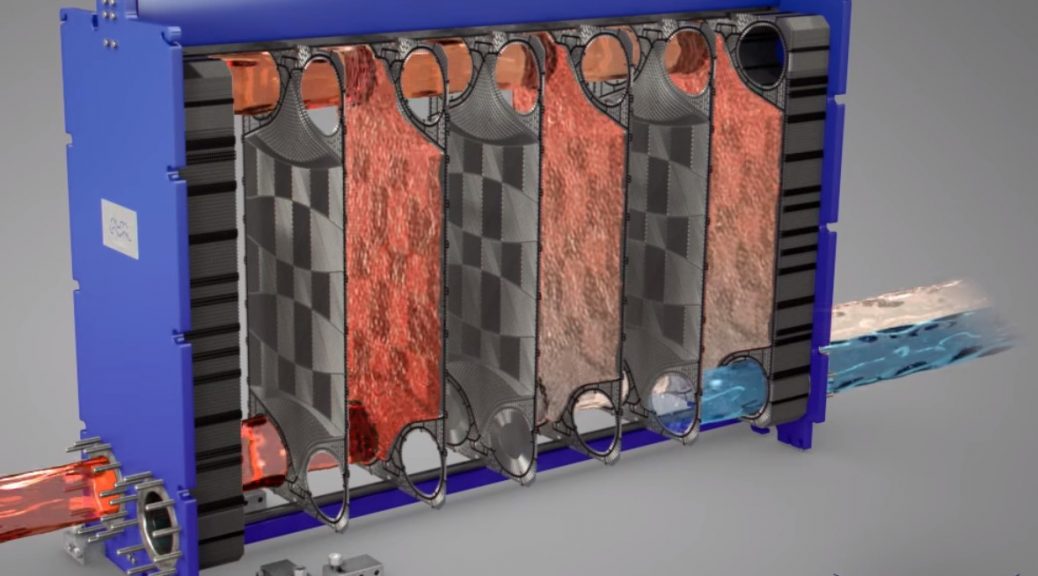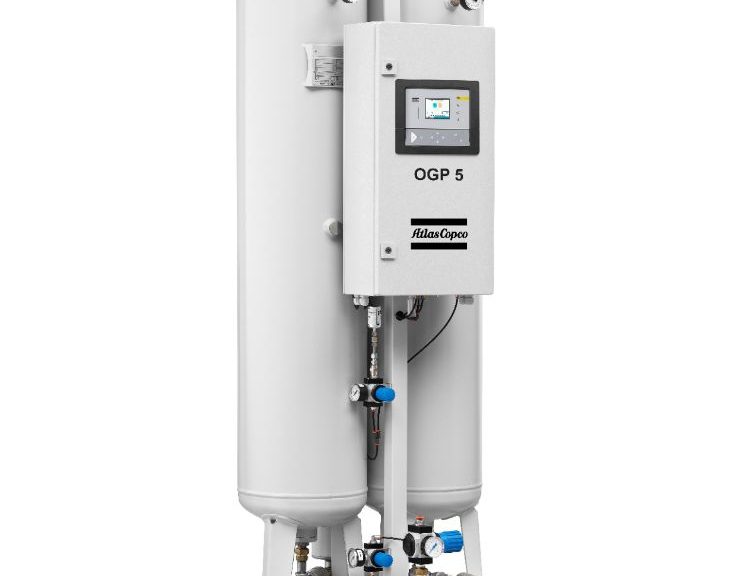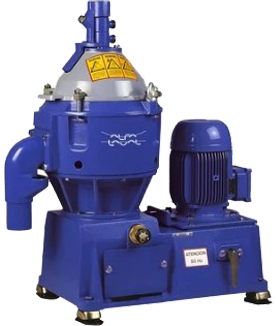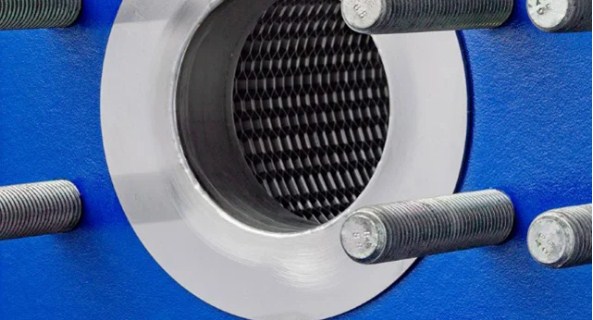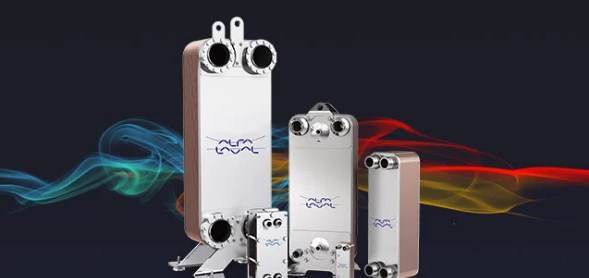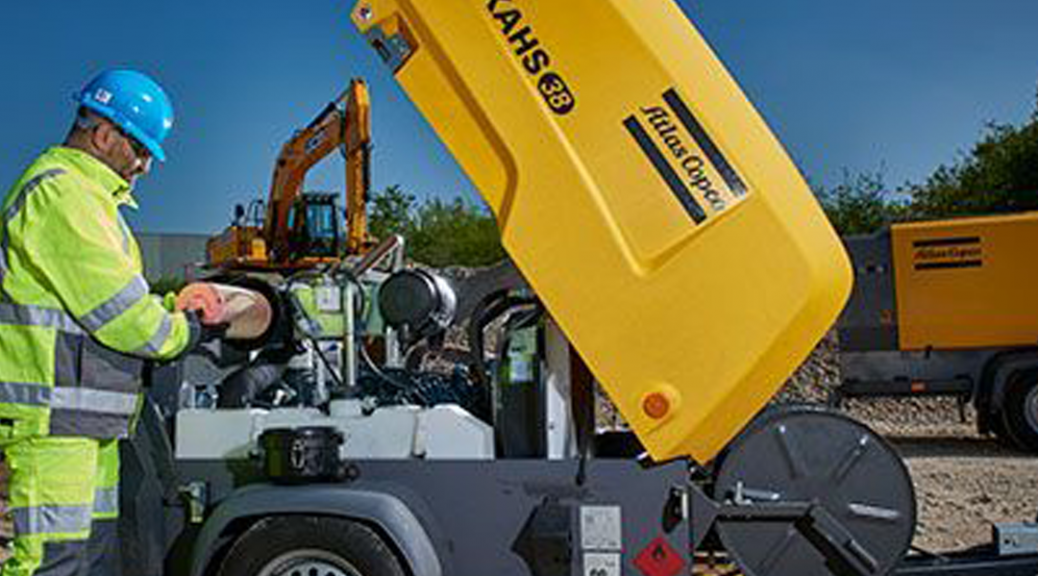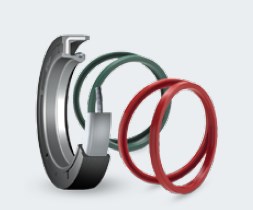Only Genuine parts stand for quality
All posts by Come on Kasi Sales
Alfa Laval 2-pass gasketed plate-and-frame heat exchanger
This animation shows the working principle of an Alfa Laval liquid/liquid 2-pass gasketed plate-and- frame heat exchanger where the fluids run counter-currently through the heat exchanger. The turning plate in the middle of the plate pack directs the flow into the two passes.
The hot liquid (illustrated in red) enters through one of the connections in the frame plate. The fluid runs through the heat exchanger in two passes and then leaves through one of the connections in the pressure plate. The cold liquid (illustrated in blue) simultaneously enters through one of the connections in the pressure plate and leaves through one the connections in the frame plate.
As the fluids pass through the heat exchanger, heat is transferred from the hot media to the cold media. Countercurrent flow enables maximum heat recovery possibilities and very close temperature approach can be achieved. Temperature cross is also possible, meaning that the hot outlet can reach a lower temperature than the cold outlet. This can only be achieved to a limited extent with tubular heat exchangers making plate-and-frame heat exchangers more thermally efficient. The fluids enter through the connections and portholes of the heat transfer plates. Specially designed sealing gaskets located between the plates direct the fluids so that the hot and cold fluids pass counter-currently in alternating channels.
When the fluid enters between the plates, it passes over the distribution area. Alfa Laval offers two types of distribution areas: our patented CurveFlowTM and the chocolate pattern. Alfa Laval’s well-designed distribution area is one of the most important features of a plate heat exchanger. Its main purpose is to ensure an even flow of fluid over the entire plate while maximizing heat transfer efficiency and minimizing maldistribution and fouling. In the animation you can see that the distribution area helps the fluids to quickly fill up the entire cross section of the plates.
The animation shows the flow principle of a conventional gasketed plate-and-frame heat exchanger with a 2-pass configuration, but additional passes are possible. It is also possible to have a different number of passes on each side of the heat exchanger. For bigger models with higher flow rates, reinforcing partition plates are sometimes used which are not shown in the animation. Specialized ranges of the gasketed plate-and-frame heat exchanger are also possible such as our semi-welded and WideGap. For very heat sensitive media, co-current flow is used in gasketed plate-and-frame heat exchangers. The benefit with this design is that the coldest fluid meets the hottest fluid when entering the heat exchanger, minimizing the risk of overheating or freezing sensitive media. In the animation, you can imagine reversing the cold fluid so that both fluids are entering at the frame plate connections. Alfa Laval has an extremely broad range of gasketed plate-and-frame heat exchangers which are used in all types of industries. The number of sizes, plate and gasket materials and available options are enormous.
Why buy OXYGEN when you can generate your own?
Solutions for Generate OXYGEN onsite.
Oxygen generators
Atlas Copco offers a range of Oxygen generators that give our customers access to a continuous supply of industrial gases. Our on-site generation systems ensure that our customers have access to high quality nitrogen or oxygen at low cost per cubic metre compare to bottled or bulk gas supply.
Just as Nitrogen, Oxygen (process gas) is vital to many industries so is the need for Oxygen in many processes in both industrial and medical applications. Atlas Copco’s OGP series of oxygen generators with Pressure Swing Adsorption (PSA) technology is a cost-efficient way produce your own, oxygen. Our PSA technology isolates oxygen molecules in compressed air. Oxygen generator only needs a source of dry compressed air to produce oxygen with a purity of 90% to 95%.
MMB series of solids-retaining separators
Mineral oils used in marine installations and power stations need purification and clarification for optimal efficiency. Clarification is an optional measure depending on its use. Purification and clarification (optional) are best done in the MMB Separation system.
The MMB series of solids-retaining separators is available in two models.
- MMB 304
- MMB 305.
Each MMB separation system comprises:
- An MMB separator
- Ancillary equipment consisting of connections and valve assembly
- Optional equipment
- Independent oil feed pump
- Oil heating system, steam or electric
- Water seal alarm MAWA-40
Features
- Compact, robust design
- Internal paring disc for discharge of clean oil
- Large sludge space
- Belt-driven
Major benefits
- Easy to install.
- Requires limited space.
- Pressurised discharge of clean oil. No need for a downstream pump.
- Fewer service man hours.
- Larger sludge space extends operating period between manual cleaning.
- Lower maintenance and spare parts costs.
Uses
- Distillates
- Marine Diesel Oils MDO up to 13 cSt at 40°C
- Lubricating oils for trunk diesel engines operating on distillates and light MDO
- Lubricating oils for steam and gas turbines
- Lubricating and hydraulic oils for hydroelectric power stations
Gasketed plate-and-frame heat exchangers
Alfa Laval doesn’t do average. Whether it is our multi-purpose Industrial range; the Semi-welded industrial range for refrigeration and exacting processes; the Hygienic range for food, beverage and pharma applications; or the Specialized range for condensation, evaporation and fibrous media – you buy into reduced cost of ownership and increased efficiency and safety.
Gasketed plate heat exchangers for modern requirements
Highest thermal efficiency and close temperature approach
Compact units – space saving, easy to service and maintain
Maximum uptime – less fouling, stress, wear and corrosion
Flexible – easy to adapt to changed duty requirements
Brazed plate heat exchangers
Alfa Laval copper-brazed plate heat exchangers are a compact, efficient and maintenance-free solution for heating, cooling, evaporation and condensing in numerous applications. Each unit is designed for duty optimization, with a range of unique features that ensure both superior thermal performance and maximum reliability. This enables the longest possible service life – even under conditions with extremely high design pressures.
With a robust and reliable construction, Alfa Laval’s comprehensive range of brazed plate technology offers a smart alternative to traditional heat exchangers. The application experience of Alfa Laval’s heating and cooling experts, combined with our continuous innovation in design and manufacturing techniques, ensures you always have access to the most competitive solution available. Example positions for our brazed heat exchangers include air conditioning and process chillers, commercial and industrial refrigeration, district heating and domestic hot water, heat pumps, gas boilers, energy storage, fuel cells, oil and fuel cooling, hydraulics, engine cooling, air compressors, and air driers.
Sustainable heat transfer
- Lightweight brazed construction offers much greater thermal efficiency than comparable shell-and-tubes with a footprint that’s 75% smaller
- The flexible DynaStatic distribution system in AC models enables higher efficiency in any evaporator duty and with any refrigerant
- Alfa Laval’s FlexFlow plate design provides channel asymmetry that can be tailored to fit the application
- We help you select the optimal pressing depth, plate pattern and configuration for your application
- An ideal solution for use with natural refrigerants, thanks to the compact footprint, optimized plate design and high design pressure
How to restart your compressor after a period of inactivity?
Our Portable Compressors are built to last. And they’re also able to cope with lockdowns, including periods of inactivity. Even so, to ensure a smooth re-start, do the 12-point check-up.
- Any leaks in your systems? No? Double-check!
- Drain water from the fuel filter and fuel tank.
- Drain water from the compressor oil vessel.
- Check the oil and coolant levels. Of both your engine and compressor. Top up when necessary.
- Check the air filter element for dirt and oil residue. Replace when needed.
- Check the non-return valve in the fuel (return) line.
- Check the electrical systems and cables.
- Check the electrolyte level and terminals.
- Check the torque on critical connections.
- Inspect the fan belt. Adjust it when necessary.
- Make sure the regulating valve functions smoothly.
- Check the tire pressure.
You’re ready for a smooth restart!
Load the unit. Build up pressure steadily. Keep monitoring the parameters.
Condition Monitoring Products
Machine condition advisor (Vibration pen)
Vibration analyzer
Thermography
Online Condition Monitoring
Sealing Solution
Rubber OD oil seals (Nitrile & viton)
Metal OD oil seals (Nitrile & viton)
Hydraulic seals (Rod, Wiper, U Cup, etc.)
0-rings
V-rings
Speedi sleeves
Customized seal
Lubrication and Lubricating Systems
SKF general purpose bearing
grease
SKF speciality lubricants (High
and low temperature grease)
Single point, multi point lubricators
Grease guns, grease meter,
grease pump etc.
Centralized lubrication system


